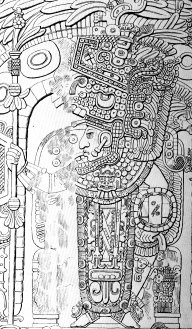
Year 734 (DCCXXXIV) was a common year starting on Friday of the Julian calendar, the 734th year of the Common Era (CE) and Anno Domini (AD) designations, the 734th year of the 1st millennium, the 34th year of the 8th century, and the 5th year of the 730s decade. The denomination 734 for this year has been used since the early medieval period, when the Anno Domini calendar era became the prevalent method in Europe for naming years.

Frisia is a cross-border cultural region in Northwestern Europe. Stretching along the Wadden Sea, it encompasses the north of the Netherlands and parts of northwestern Germany. The region is traditionally inhabited by the Frisians, a West Germanic ethnic group.

The counts of Holland ruled over the County of Holland in the Low Countries between the 10th and the 16th century.
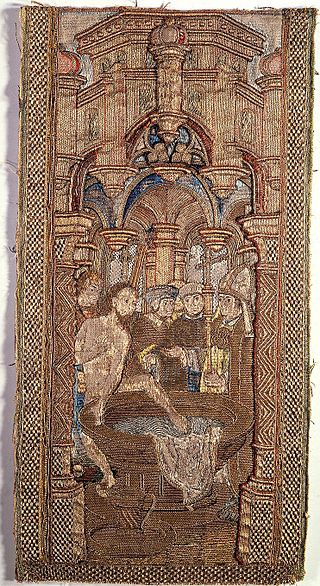
Radbod was the king of Frisia from c. 680 until his death. He is often considered the last independent ruler of Frisia before Frankish domination. He defeated Charles Martel at Cologne. Eventually, Charles prevailed and compelled the Frisians to submit. Radbod died in 719, but for some years his successors struggled against the Frankish power.

The County of Holland was a state of the Holy Roman Empire and from 1433 part of the Burgundian Netherlands, from 1482 part of the Habsburg Netherlands and from 1581 onward the leading province of the Dutch Republic, of which it remained a part until the Batavian Revolution in 1795. The territory of the County of Holland corresponds roughly with the current provinces of North Holland and South Holland in the Netherlands.
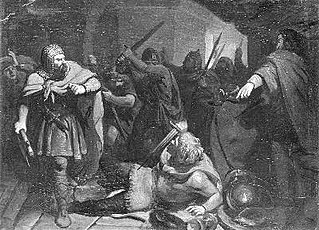
Godfrid, Godafrid, Gudfrid, or Gottfrid was a Danish Viking leader of the late ninth century. He had probably been with the Great Heathen Army, descended on the continent, and became a vassal of the emperor Charles the Fat, controlling most of Frisia between 882 and 885.

Dirk V was Count of Holland from 1061 to 1091.
Dirk III was the count with jurisdiction over what would become the county of Holland, often referred to in this period as "West Frisia", from 993 to 27 May 1039. Until 1005, this was under regency of his mother. It is thought that Dirk III went on pilgrimage to the Holy Land around 1030, hence his nickname of Hierosolymita.
Dirk I was count of West Frisia, later known as the County of Holland. He is thought to have been in office from c. 896 to c. 928 or 939.
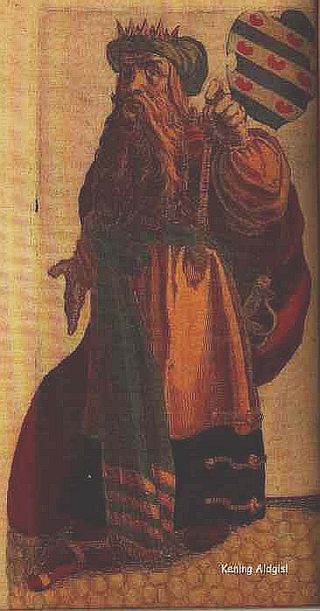
Aldegisel was the ruler of Frisia in the late seventh century contemporarily with Dagobert II and a very obscure figure. All that is known of him is in relation to the famous saint that he harboured and protected, Wilfrid, but he is the first historically verifiable ruler of the Frisians.
Gerolf or Gerulf was the second count of this name who is attested in the area of Friesland. Gerolf's main area of power seems to have been in Kennemerland. Count Gerolf is often regarded as the founder of the County of Holland, although the actual name "Holland" is from a later time. His ancestry is unclear, but he may have been a son or, more likely, a grandson of the earlier Gerolf, who was a count in the area of Frisia at the time of the reign of Emperor Louis the Pious and who later joined a monastery. The earlier Gerolf died in 855. There is some limited and vague evidence that this earlier Gerolf was a son of a certain Theodoric, who in turn supposedly descended from the Frisian king Redbad. Count Gerolf is often identified as the father of Count Dirk I and seen as the founder of the first house of the Counts of Holland, which ruled the county until it was inherited by John II of Hainaut in 1299.

Liudolf of Brunswick was Margrave of Frisia, Count of Brunswick, Count in the Derlingau and the Gudingau.

Frisian freedom was the absence of feudalism and serfdom in Frisia, the area that was originally inhabited by the Frisians. Historical Frisia included the modern provinces of Friesland and Groningen, and the area of West Friesland, in the Netherlands, and East Friesland in Germany. During the period of Frisian freedom the area did not have a sovereign lord who owned and administered the land. The freedom of the Frisians developed in the context of ongoing disputes over the rights of local nobility.
Arnulf, also known as Arnoud or Arnold, succeeded his father in 988 as Count of Frisia, which by around AD 1100 would come to be referred to as the county of Holland. He was born in 951 in Ghent and because of this he is also known as Arnulf of Ghent. Arnulf was the son of Dirk II, Count of Holland and Hildegard of Flanders. He was named after his maternal grandfather.
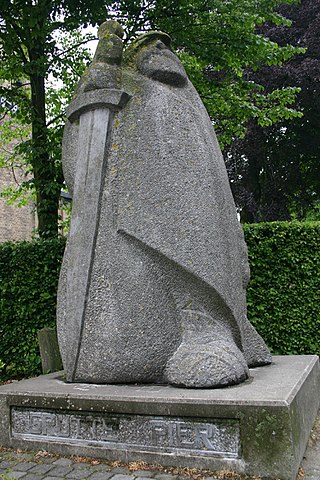
Frisia has changed dramatically over time, both through floods and through a change in identity. It is part of the Nordwestblock which is a hypothetical historic region linked by language and culture,where they may have spoken an Indo-European language which was neither germanic nor celtic.

The Frisian–Frankish wars were a series of conflicts between the Frankish Empire and the Frisian kingdom in the 7th and 8th centuries.

The Frisian Kingdom, also known as Magna Frisia, is a modern name for the post-Roman Frisian realm in Western Europe in the period when it was at its largest (650–734). This dominion was ruled by kings and emerged in the mid-7th century and probably ended with the Battle of the Boarn in 734 when the Frisians were defeated by the Frankish Empire. It lay mainly in what is now the Netherlands and – according to some 19th century authors – extended from the Zwin near Bruges in Belgium to the Weser in Germany. The center of power was the city of Utrecht.
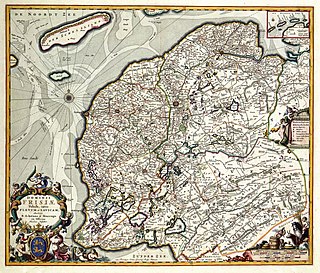
The Lordship of Frisia or Lordship of Friesland was a feudal dominion in the Netherlands. It was formed in 1498 by King Maximilian I and reformed in 1524 when Emperor Charles V conquered Frisia.
Gerulf, also Gerulf the Elder, was the first count of Frisia by this name and an ancestor of the Counts of Holland. Initially dispossessed for opposing emperor Louis the Pious, Gerulf was given back his lands in 839.


















